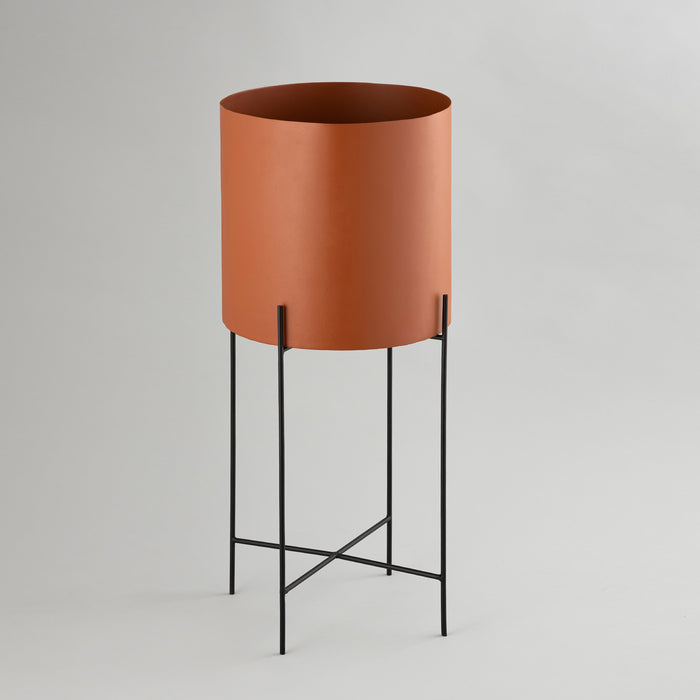What is Terracotta?
Terracotta is a type of clay-based ceramic material that has been used for thousands of years for various purposes. It is composed of clay as the base material, along with minerals and colorants for added properties and aesthetics. The process of making terracotta involves shaping the clay, firing it at high temperatures, and sometimes glazing it. Terracotta has a long history, from ancient civilizations like Mesopotamia and Greece to modern architectural and artistic applications. It is used in architecture for items like tiles and facades, in art for sculptures and pottery, and in home decor for planters and tableware. Terracotta requires proper care to maintain its appearance and durability as it can be susceptible to staining and cracking.
Terracotta Composition

Terracotta, a versatile medium renowned for its rustic charm and historical significance, is primarily composed of clay as its base material. The key ingredient, clay, provides the fundamental structure and workability essential for crafting terracotta artifacts. Its malleability allows artists to shape intricate forms, ranging from pottery to sculptures, with ease.
To enhance both the aesthetic appeal and functional properties of terracotta, various minerals and colorants are integrated into the composition. These additional elements serve multiple purposes. Minerals, such as silica and feldspar, contribute to the structural integrity and durability of the final product. Colorants, derived from natural sources or synthetic pigments, infuse the terracotta with a diverse palette, enabling artists to achieve a spectrum of hues.
Terracotta vs. Clay: Is There a Difference?
Terracotta and clay are related materials, but there are key differences between them in terms of composition, usage, and characteristics. Clay is a broad term referring to a natural earthy material that results from the decomposition of rocks. It is primarily composed of fine particles of minerals, such as kaolinite, illite, and montmorillonite. Clay is highly plastic when wet, allowing it to be easily molded into various forms. It serves as a foundation for a variety of ceramics, including terracotta.
Terracotta, on the other hand, is a specific type of clay-based ceramic. The term "terracotta" translates to "baked earth" in Italian, reflecting its characteristic reddish-brown color. Terracotta often contains additional minerals and additives to enhance its properties, and it undergoes a firing process to harden the clay. Terracotta is commonly used for pottery, sculptures, and architectural elements due to its durability and distinctive appearance.
History of Terracotta
Terracotta has a rich history spanning millennia, originating from ancient civilizations like the Indus Valley, Mesopotamia, and China. The term, derived from Italian, signifies its earthy composition and the baking process. In ancient times, it was extensively used for pottery, figurines, and architectural embellishments. The Terracotta Army from China's Qin Dynasty stands as a monumental testament to its artistic and utilitarian applications. Across ancient Greece and Rome, terracotta adorned structures and statues, influencing European art through the Middle Ages and the Renaissance. Today, terracotta's warm hues and durability sustain its popularity, whether in pottery, sculptures, or architectural ornamentation, underscoring its enduring significance in global artistic and cultural heritage.
Ancient Origins
Terracotta, with its ancient origins, holds a storied history across diverse civilizations. In Mesopotamia, it emerged as a crucial medium for pottery and artistic expression, showcasing the early mastery of this versatile material. The renowned Terracotta Warriors of China, crafted during the Qin Dynasty, exemplify the scale and artistry achieved with terracotta, immortalizing an army in clay.
Across ancient Greece and Rome, terracotta played pivotal roles in architectural embellishments, sculptures, and pottery. Greek artisans skillfully incorporated terracotta into decorative elements, while Roman architects utilized it for various structural and ornamental applications. This historical journey underscores terracotta's enduring significance, evolving from Mesopotamian pottery to the monumental legacy of Chinese warriors, and influencing the artistic landscapes of ancient Greece and Rome.
Terracotta in Architecture
Terracotta has left an indelible mark on architectural history, with notable chapters in the Renaissance and modern eras. During the Renaissance, Italian sculptors like Luca della Robbia elevated terracotta to new heights, using it for ornate reliefs and sculptures that adorned buildings. This period witnessed a revival of interest in classical art, and terracotta became a favored material for architectural embellishments.
In modern architecture, terracotta continues to thrive. Its adaptability, durability, and aesthetic appeal make it a sought-after material for contemporary designers. Terracotta facades, tiles, and decorative elements grace buildings worldwide, marrying traditional warmth with modern functionality. From the intricate detailing of Renaissance masterpieces to the sleek lines of contemporary structures, terracotta remains a timeless and versatile choice in shaping architectural landscapes.
Terracotta in Art and Sculpture
Terracotta, with its rich history and malleable nature, has been a cornerstone in the realm of art and sculpture. Its versatility allows artists to create intricate and enduring pieces that span various styles and eras.
Terracotta Artworks
Terracotta artworks encompass a wide array of creations, ranging from detailed figurines and reliefs to large-scale sculptures and installations. The material's earthy warmth and pliability make it conducive to expressing intricate details, capturing the essence of both realistic and abstract forms. Artists throughout history have harnessed the unique qualities of terracotta to produce timeless and culturally significant pieces.
Famous Terracotta Sculptures
Famous terracotta sculptures abound in artistic history. Notably, the Terracotta Army of China, an army of life-sized clay soldiers crafted during the Qin Dynasty, stands as an unparalleled testament to the mastery of terracotta sculpting. Additionally, works by renowned artists like Luca della Robbia in the Renaissance showcase how terracotta has been integral to sculptural masterpieces.
Contemporary Terracotta Artists
In contemporary times, a new generation of artists continues to explore and push the boundaries of terracotta sculpture. With a fusion of traditional techniques and modern aesthetics, these artists breathe fresh life into the medium. Their works often reflect diverse themes, from cultural commentary to abstract expressions, contributing to the evolving narrative of terracotta in contemporary art.
Creating with Terracotta
The process of creating with terracotta involves a combination of traditional techniques and innovative approaches, encompassing both sculpting and pottery.
Techniques in Terracotta Sculpting
Terracotta sculpting involves various techniques, including hand-building, coiling, and molding. Artists meticulously shape the clay, allowing for intricate detailing. After the initial sculpting, the terracotta undergoes a firing process, transforming it into a durable and permanent form. The techniques employed often vary based on the artist's vision and the desired outcome, resulting in a diverse range of terracotta sculptures.
Terracotta in Pottery
Terracotta's role extends beyond sculpture to pottery. Pottery crafted from terracotta is known for its porous nature and warm color palette. Artists shape functional vessels, decorative plates, and other utilitarian objects using techniques like wheel-throwing or hand-building. The firing process not only solidifies the pottery but also imparts a distinctive reddish-brown hue, adding to the allure of terracotta in the world of functional art.
Practical Uses of Terracotta
Terracotta's practical applications extend beyond art and sculpture, finding a place in building construction, home decor, and everyday items.
Terracotta in Building and Construction
Terracotta Tiles: Terracotta tiles, prized for their durability and aesthetic appeal, are used in flooring, both indoors and outdoors. Their natural warmth and unique character make them a popular choice for spaces seeking a timeless and earthy ambiance.
Terracotta Facades: In architecture, terracotta is employed in facades to add decorative elements and character to buildings. The material's ability to withstand weathering while maintaining its visual appeal makes it a favored choice for both historic and modern structures.
Home Decor with Terracotta
Terracotta Planters: Terracotta's breathability makes it an ideal material for planters. It helps regulate soil moisture and temperature, creating an optimal environment for plant growth. Terracotta planters also contribute to a rustic and charming aesthetic in gardens and indoor spaces.
Terracotta Tableware: The use of terracotta extends to tableware, where its natural, earthy tones enhance the dining experience. Plates, bowls, and other tableware crafted from terracotta add a touch of warmth and authenticity to the dining table.
Caring for Terracotta
Proper care is essential to preserve the beauty and longevity of terracotta items, whether they are architectural elements or household items.
H3: Cleaning and Maintenance
Regular cleaning is crucial to remove dirt and prevent the buildup of contaminants on terracotta surfaces. Gentle cleaning with a soft brush or cloth, along with mild, pH-neutral cleaners, helps maintain the material's integrity.
Removing Stains: For stubborn stains, a paste of baking soda and water can be applied to the affected area. This paste, left on the stain for a short period, helps lift the discoloration without damaging the terracotta.
Preventing Cracks: Terracotta can be prone to cracking, especially in extreme temperature changes. To prevent cracks, avoid sudden exposure to direct sunlight or placing hot items directly on terracotta surfaces. Additionally, applying a sealant can enhance the material's resistance to water absorption.
Weathering and Patina
Terracotta naturally weathers over time, developing a distinctive patina that adds character. This aging process is often embraced for its aesthetic appeal. However, protecting terracotta from excessive moisture and extreme weather conditions can slow down the weathering process, preserving the original appearance for longer periods.
Conclusion
In conclusion, terracotta stands as a timeless and versatile material that has significantly shaped the realms of art, architecture, and practical applications. From its ancient origins in Mesopotamia to its prominence in the building facades of today, terracotta has woven a rich narrative of cultural and artistic significance.
In the world of art and sculpture, terracotta has been harnessed by both ancient and contemporary artists, creating iconic pieces that span a spectrum of styles and expressions. Its use in renowned sculptures like the Terracotta Warriors of China and the masterpieces of the Renaissance attests to its enduring appeal.
Faqs
What is terracotta?
Terracotta, derived from Italian words meaning "baked earth," is a clay-based ceramic material known for its natural reddish-brown color. It has a long history of use in art, sculpture, architecture, and practical applications.
How is terracotta different from clay?
Clay is a broad term for natural earthy material, while terracotta is a specific type of clay that has been fired. Terracotta often contains additional minerals and undergoes a firing process to create durable pottery, sculptures, and architectural elements.
What are some famous terracotta sculptures?
The Terracotta Warriors of China, created during the Qin Dynasty, are iconic examples of terracotta sculpture. Additionally, works by artists like Luca della Robbia during the Renaissance showcase terracotta's influence on sculptural masterpieces.
Where is terracotta used in architecture?
Terracotta is used in architecture for various purposes. It is employed in tiles for flooring, facades for decorative elements on buildings, and as a construction material for its durability and aesthetic appeal.
How can I care for terracotta items?
Regular cleaning with a soft brush or cloth and mild cleaners is recommended. To remove stains, a paste of baking soda and water can be used. Preventing exposure to extreme temperatures and applying a sealant can help prevent cracks and preserve the terracotta's integrity.
What are the practical uses of terracotta?
Terracotta has practical applications in building and construction, including tiles and facades. It is also used in home decor for planters and tableware, contributing to a rustic and charming aesthetic.
How does terracotta weather over time?
Terracotta naturally weathers, developing a patina that adds character. Protecting it from excessive moisture and extreme weather conditions can slow down this process, preserving its original appearance for longer periods.
